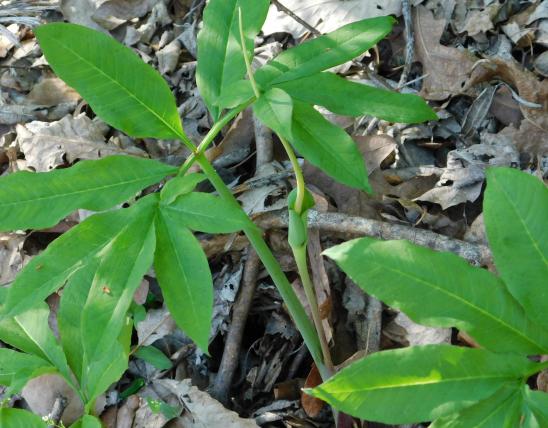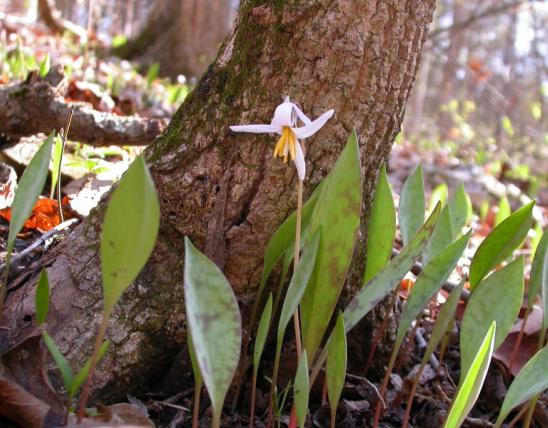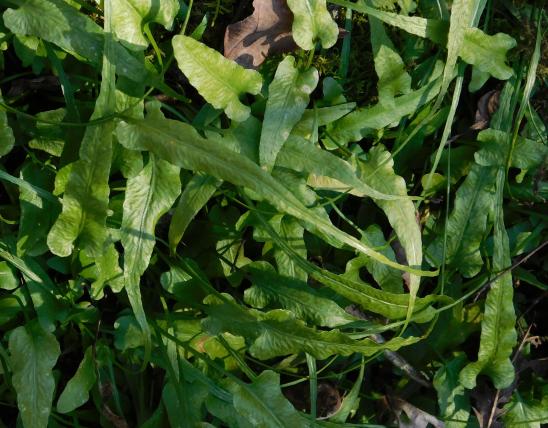
Adder’s tongue ferns don’t look like typical ferns. They have simple, spoon-shaped leaves and an upright spore-bearing stalk. Often overlooked, these perennial ferns are only visible for a few months each year. Like all members of the family, each true leaf actually comprises two sections that look quite different: a vegetative portion (the part that looks like a leaf), and a fertile portion, which is an upright stalk that bears spore-producing clusters at its top. Examining the junction of these two portions reveals a simple diverging split in the veins of the leaf stalk (not the typical joint where leaf stems usually attach to a stalk).
The vegetative (leafy) portion is sessile or short-stalked, lance-shaped to ovate in outline, sheaths the stalk of the fertile spike. The veins are branched and form copious networks. The fertile (spore-bearing) portion is an erect, long-stalked spike. The spore-bearing section occurs in 2 rows on opposite sides of the tip.
Missouri has 4 species in genus Ophioglossum:
- Engelmann’s adder’s tongue, or limestone adder’s tongue (O. engelmannii), is our most common representative. It occurs mostly in the southern two-thirds of the state, on limestone and dolomite glades, bluffs, and outcrops, and sometimes also in rocky openings of upland forests on dolomite. Height: 3–14 inches. Key features include: leafy portion somewhat folded lengthwise, usually sharply pointed at the tip; on the leaf blade, the main veins enclose small regions in which smaller veins form a netlike pattern. Populations often produce only vegetative foliage. This species sometimes also produces new leaves when fall rains bring moisture after a dry summer. It releases spores March–October.
- Southern adder’s tongue (O. vulgatum) occurs in eastern Missouri north to Lincoln County. It lives in rich soils of moist forests, often in the bottoms of ravines, and in bottomland forests. It’s our only adder’s tongue that is usually found in deep shade. Height: 2–12 inches. The veins in its leaves form rather simple networks, with all the veins about the same size. Also, the leafy portion is flat or somewhat concave (bowl-shaped; not folded lengthwise), lacks a sharp-pointed tip, has a generally rounded tip, and is shiny. It releases spores April–August.
- Bulbous adder’s tongue (O. crotalophoroides), in Missouri, is at the extreme northwest edge of its overall range. In our state it is known from only one location in Oregon County. It occurs in disturbed lawns. There’s a good chance it occurs elsewhere, especially, perhaps, in cemeteries of southeastern Missouri. Height: very small, only ½–1½ inches. Its below-ground stems are globe-shaped, like corms (not cylindrical and rootlike). The vegetative portion of the leaf often lays flat on the ground. It releases spores March–June.
- Stalked adder’s tongue (O. petiolatum) is also at the edge of its range in Missouri; this is about as far north as it occurs. It is known only from a single location in Pemiscot County. It occurs in disturbed lawns in sandy soil. It is similar to southern adder’s tongue, but each plant sends up 2–4 leaves (not just 1) from the ground, and the vegetative portion of each leaf narrows at its tip (the tip isn’t rounded). It releases spores April–June.
Habitat and Conservation
Each of Missouri’s adder’s tongue species is associated with a different habitat, so if you have found an adder’s tongue plant, take into account the habitat where it’s living. It may be a key in determining its identity. The habitat preferences for each are outlined in the description section above.
Adder’s tongues are probably more widespread in Missouri than botanical records indicate, because the plants are easily overlooked and only appear aboveground for a few months each year.
Status
Life Cycle
Human Connections
Globally, adder’s tongues have been used in folk remedies for a variety of ailments.
Adder’s tongues’ common and genus names both come from an imagined resemblance of the fertile spike to a snake’s tongue. Ophioglossum’s Greek roots mean “snake-tongue.”
Engelmann’s adder’s tongue honors botanist and medical doctor George Engelmann (1809–1884), a German immigrant who became one of Missouri’s most celebrated botanists. He founded the St. Louis Academy of Science, formally described hundreds of plant species, and played a key role in creating what is now the library and herbarium — and the enduring scientific mission — of the Missouri Botanical Garden.
There are precise names for the two portions of an adder’s tongue leaf: the vegetative (leafy) portion is called a trophophore, and the fertile (spore-producing) portion is called a sporophore. The words have Greek roots. The “troph-” of trophophore refers to nutrition (because the leaves conduct photosynthesis, which makes food for the plant). The “-phore” part of the word means “carrier” or “bearer.” Now that you know this, you can figure out what sporophore means!
Ecosystem Connections
The success of adder’s tongue ferns is tied to the destiny of their fungal partners. Anything that harms the fungi needed by the ferns will also harm the ferns. Some factors that can impact the fungi’s survival include timber harvesting, road building and other construction, and any land use changes that affect the soil’s drainage and moisture, chemistry, and other characteristics.
At first glance, the leaf arrangement of adder’s tongues superficially resembles the flowers of plants in the arum family, such as peace lilies, elephant ear, and jack-in-the-pupit. But closer inspection reveals major differences. Arums are seed plants, while adder’s tongues are ferns. Ferns make spores and never make seeds.
































